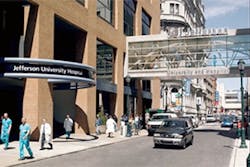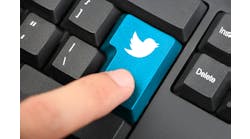At Jefferson Health, a Success Story Around ED Teletriage That Offers Hope in the Emerging COVID-19 Pandemic
Could the clinical management of already-busy emergency departments (EDs) be enhanced through a smart combination of clinician staffing management and the leveraging of telehealth technologies, especially at a time of crisis because of the COVID-19 virus? Leaders at the Philadelphia-based Jefferson Health system, with its 908-licensed-bed Thomas Jefferson University Hospitals at its organizational core, think so.
Already geared up to serve patient needs through their robust JeffConnect telehealth program, Jefferson Health clinician leaders have been moving in the past few years to optimize the human resources of their emergency physicians. Among those leading a broad initiative in this area has been Aditi Joshi, M.D., medical director of JeffConnect, and an assistant professor in the Department of Emergency Medicine at Jefferson Health. Under her leadership, JeffConnect has expanded both its breadth and scope, at two key facilities, Jefferson Methodist Hospital in South Philadelphia, and at the flagship Thomas Jefferson University Hospital in Center City Philadelphia.
In that context, Dr. Joshi and her colleagues have been partnering with the Brookfield, Wis.-based EmOpti, which which provides specialized telehealth technnology to hospital emergency departments, enabling board-certified emergency physicians to work remotely to triage and diagnose patients through busy EDs.
On March 19, EmOpti announced that it would be offering hospitals use of its tele-triage technology for 90 days free of charge, in order to help them manage the anticipated (and in some places, already current) surge of cases flooding into EDs, some of them COVID-19-related.
On March 20, Dr. Joshi spoke with Healthcare Innovation Editor-in-Chief Mark Hagland regarding JeffConnect, the partnership with EmOpti, and broader issues facing hospitals in the wake of the emergence of the COVID-19 pandemic. Below are excerpts from that interview.
Tell me about the ongoing evolution of JeffConnect and about your team’s efforts to optimize ED management in your hospital facilities?
We’ve been working forward on a number of fronts, going live with JeffConnect, and adding in our partnership with EmOpti. We initially went live with teletriage at Methodist, seven hours a day, in October 2017, and then went live in our Center City hospital in April 2018. Center City started out with a different model from the model we had implemented at Methodist; at Center City, we had a physician triaging patients in person, and used our teletriage as a second layer of coverage, helping out the in-person physician. Later, we shifted to a totally remote model of teletriage delivery at Center City as well. In both facilities, we’re engaged with EmOpti for the remote ED physician teletriage.
The implementation in both hospitals involved several distinct phases. Over time, we’ve extended the hours of teletriage from the general intake hours, 8 AM to 1 AM, and weekends, 9 AM to 1 AM on weekends.
What has the experience of engaging with teletriage been like for you as a practicing ED physician?
I’ve been working in the telemedicine space for seven years, so for me, doing this on video is not that different. It’s slightly different from working with home-based patients, because the visits are shorter; you’re just getting the orders down. Some people really took to it, and the reality is that most people we were able to give tips to, we try to give everybody the same standardized practice, but everyone’s individual. And variation is true in regular practice.
Has it made you much more efficient?
Absolutely. We were able to bring our time-to-provider down to 14 minutes from more than 20, at Methodist. And the patients categorized as “left without being seen,” went from over 2.1 percent to 0.9 percent.
How has it been for the whole team? And for patients?
Initially, physicians were the only ones doing it, and they took to it. These providers were already doing telemedicine anyway. Meanwhile, nurses just made it a part of their triage process at Methodist. The nurses at Center City had been using the techs to obtain patients’ vital signs and get the chief complaint. But now we’ve changed the model even at Center City, so we’re doing it out of our triage rooms, as we had already been doing it at Methodist.
What have been your biggest learnings so far?
I think the biggest surprise for us was that once you try a new intervention, you uncover other problems you had had. We were able to get people into the ED faster and get their orders done faster. But we realized that getting patients admitted remained a problem. But because we were able to get orders done sooner, patients at least were seen faster. And that’s probably better for patient safety. The other general learning is that this is actually a very easy thing to accomplish, and the technology implementation doesn’t take a lot of time. You just need staff willing to learn, and comfortable doing it.
How might this impact care delivery now during the COVID-19 pandemic?
This might help us. We need to keep as much protective equipment as we can, and perform judicious testing. And because we have thigs set up for this, we don’t need as many people being gowned and masked. And we’ll be rolling out a testing site outside of our ED; and because we already have the training and technology, we could see them before they even come inside the building. So we’ll be able to use this at a closer scale in the ED an other places in the hospital, to get people to the right place for testing. Can they go straight to the testing site? Or will they need to go to the hot zone where they’ll need respiratory isolation? We could do this a little bit more safely, and keep resources.
When you look at an anticipated explosion in patient care delivery need in the coming weeks, what are your thoughts about how telehealth might be vital to the healthcare delivery system’s ability, and your organization’s ability in particular, to respond?
Right now, we’ve been successful in our area in using JeffConnect on demand at home. We’ve had a four-fold increase in patients, and have had a ton of patients tested, so that’s been successful so far. Our uptake in ED hasn’t happened yet, but we know it will. So we’ve had more time to prepare, because we did not have an influx of people coming in for well testing or mild-symptom testing. But at some point, when more patients come into the ED, we’ll have to think about how we’ll keep our clinicians and staff safer.
So having a telehealth system in place already was a huge advantage?
Yes, a huge advantage. And we’ll have to see what happens. And EmOpti is going to be giving it away for free. But the technology is not the difficult part; it’s getting your staff ready and trained to do this. So based on training hundreds of physicians, myself—you want to take this as simple as possible. And per corona testing, you should be able to use this with any staff; and they don’t necessarily need to be in the ED at all. Let’s say a person is quarantined or high-risk; this could really help everyone. It’s a huge way to help everyone be safer.


